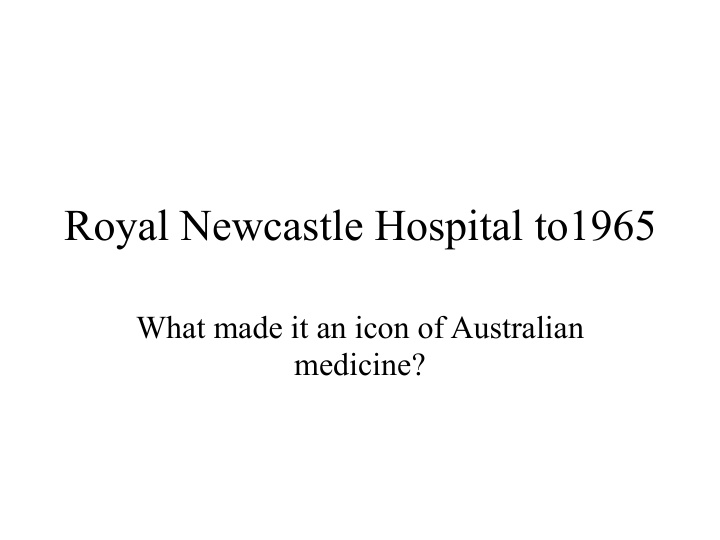



Royal Newcastle Hospital to1965 What made it an icon of Australian medicine?
McCaffrey 1932-65 Flexner 1910 Haldane 1913 Rankin 1913-1951 Starr 1932-9
“In order…to reconstruct a London medical school in modern lines it would be necessary to completely reconstruct the staff, to break up the present method of appointment by seniority, to salary teachers of medicine in order that they may devote their main time and thought to teaching and investigation…” Flexner 1913
“clinical teaching in London remains an incident in the life of a busy consultant who…visits twice weekly in the afternoon, perhaps between two and four.” Flexner 1913
“The problem is to place….teachers…in the same relation to the University as the Professors of Physiology or Physics…[in] a department …in which the three functions of a hospital [patient care, teaching and research] may be utilised.” Osler 1913
1932: Ken Starr- Medical Superintendent 1936: recommends staff classification, RMOs, teaching 1939: Chris McCaffrey Medical Superintendent 1947: Staff Specialist appointments Ethel Byrne Peter Hendry Ivan Schalit 1955: Blueprint of Medical School 1965: McCaffrey’s precipitous departure
Royal Newcastle Hospital Principles • Patient welfare is the first consideration, • There must be a critical, questioning approach to health care, • Health care should be cost effective, • Health care should be safe and efficient, • There must be a genuine concern for the welfare of the staff.
Underlying Agenda • Fulltime medical staff head of departments and teaching • Fee for service risks overservicing • Outpatient Contribution Scheme facilitates care • Outpatient care promotes continuity • Inpatient care is an episode in a continuum
Nursing reorganization Cleaning cleaning staff Food service dietary department “Sterilizing” CSD Stores impress system Tutoring trained tutors Messages courier service Management training and specialization
By 1951: • RMOs on 3 year training program • Waiting list for nursing • RMO/ medical staff dining room: all ranks join in discussion HAPPY ENVIRONMENT
McCaffrey Maxims • “Question everything- but particularly the facts.” • “A hospital is a machine for the care of the sick. It is not a workshop for the benefit of doctors or nurses or anybody else.” • “If you hear a young man say “I wonder… listen carefully. It may be the beginning of an exciting idea which is a very fragile thing.”
Innovations 1 1. Salaried full-time specialists* 2. Structured RMO training: 3 years 3. Domiciliary care * 4. Professionalization of nursing* 5. Unit Record System* 6. Audits, peer review, death meetings 7. Intensive care/recovery ward* 8. CSD with graduate Director * Still present
Innovations 2 1. Antibiotics restriction 2. Rooming in: Obstetrics* 3. Clerical Training School 4. Universal Request Form 5. Dictating machines:OP/OT/records* 6. Functional OPD layout – Mayo Model 7. Radical Mastectomy out* 8. IV bicarbonate in DKA* * Still present
Happy Hospital • Common Dining/Tea Room (Medical) • Teaching Environment • Beach and Beach Hotel • Quasi Equality • Guided Democracy
Opposition • AMA • VMOs • Profession • Sydney Establishment • “Reds under the bed”
Wash up • No succession plan • Too radical for the times • AMA/Profession/Health Department largely destroyed it GHETTO MENTALITY
Successes • Altered(?) Health care practice • Its trainees • Recognition/ Colleges/AMs • Newcastle Medical School
Recommend
More recommend